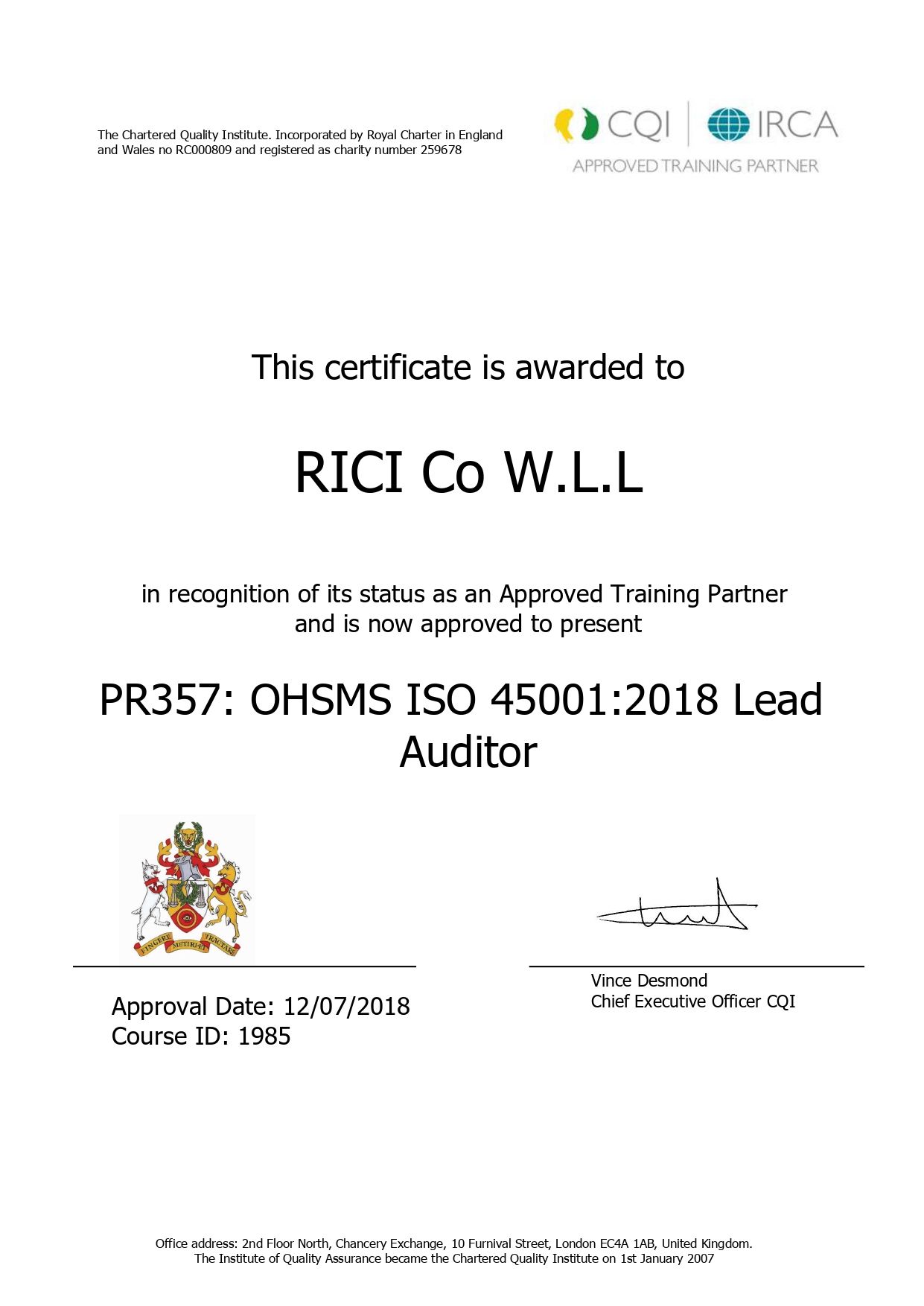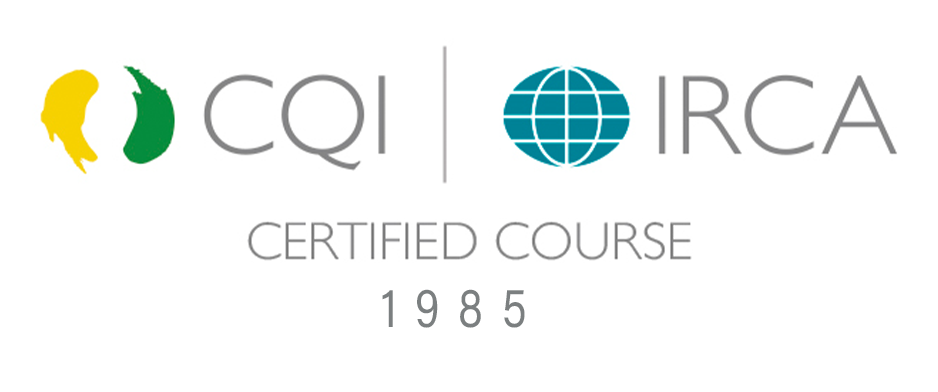How can we help you?
To discover how our services can benefit you, or to receive a free, no commitment quotation, please contact us.
PR357: Occupational Health and Safety Management System ISO 45001:2018 Lead Auditor (CQI and IRCA Course Approval No – 1985)
To make any management system successful, auditing is a very basic, and crucial, element. This course is an intensive and highly-rated 5-day program for the preparation of delegates for the qualification of ISO 45001:2018 and seeks to prepare them on how to conduct an audit. The overall concept of the course is to provide practical and theoretical knowledge of the Occupational Health & Safety Management System.
ISO 45001 is the first global Occupational Health and Safety Management System standard that replaces OHSAS 18001. The RICI Certified ISO 45001 Lead Auditor training course helps in developing the necessary skills to perform occupational health and safety management system (OH&S MS) audits by applying widely recognized audit principles, procedures, and methods.
This training course has been developed to reflect the importance of an effective audit. It strengthens your knowledge and skills to plan and carry out an OH&S MS audit in compliance with the guidelines for auditing management systems provided in ISO 19011.
The 5-day training program consists of exercises that are designed to help you practice the most important aspects of an OH&S MS audit: ISO 45001 requirements, auditing principles, tools and techniques used to obtain evidence, leading a team of auditors, conducting interviews with auditees, reviewing documented information, drafting nonconformity reports, and preparing the final audit report.
After acquiring the necessary expertise to perform this audit, you can sit for the exam and apply for a CQI and IRCA approved ISO 45001 Lead Auditor credential. By holding a CQI-IRCA-approved ISO 45001 Lead Auditor Certificate, you will demonstrate that you have the capabilities and competencies to audit organizations based on best practices.
The course provides a robust system to maintain and continually improve the health and safety of employees, sub-contractors, and the public. It improves an organization’s corporate image and credibility among stakeholders, regulators, customers, prospective clients, and the public. The course also improves the incident investigation process and maintaining compliance with legal requirements.
The main objective of this course is to create awareness within an organization regarding various basic requirements of the OHSAS standard & convey working knowledge on how these requirements can be explained to suit the organization’s processes, products, people & related, interested parties.
5 Days
To discover how our services can benefit you, or to receive a free, no commitment quotation, please contact us.
| Test No. | Test Name | ASTM Standard Method | BS Standard Method |
|---|---|---|---|
| 2 | Sampling Freshly Mixed Concrete | ASTM C172 | BS EN 12350-1 |
| 3 | Temperature of Freshly Mixed Hydraulic-Cement Concrete | ASTM C1064 | - |
| 4 | Slump of Hydraulic-Cement Concrete | ASTM C143 | BS EN 12350-2 |
| 5 | Density (Unit Weight), Yield, and Air Content (Gravimetric) of Concrete | ASTM C138 | BS EN 12350-6 |
| 6 | Air Content of Freshly Mixed Concrete by the Pressure Method | ASTM C231 | BS EN 12350-7 |
| 7 | Making and Curing Concrete Test Specimens in the Field | ASTM C31 | BS EN 12390-1/2 |
| 8 | Density of Hardened Concrete | - | BS EN 12390-7 |
| 9 | Water Storage Tanks Used in the Testing of Hydraulic Cements and Concretes | ASTM C511 | - |
| 10 | Capping Cylindrical Concrete Specimens | ASTM C617 | - |
| 11 | Compressive Strength of Cylindrical/ Cubical Concrete Specimens | ASTM C39 | BS EN 12390-3 |
| Serial Number | Test Name | ASTM Standard Method | BS Standard Method |
|---|---|---|---|
| 1 | Sampling Aggregates | ASTM D75 | BS EN 932-1 |
| 2 | Reducing Samples of Aggregate to Testing Size | ASTM C702 | BS EN 932-2 |
| 3 | Aggregate Moisture Content | - | BS 812-109 |
| 4 | Sieve Analysis of Fine and Coarse Aggregates | ASTM C136 | BS EN 933-1 |
| 5 | Material Finer than 75-µm Sieve and 63-µm Sieve in Aggregates by Washing | ASTM C117 | BS EN 933-2 |
| 6 | Clay Lumps and Friable Particles in Aggregates | ASTM C142 | - |
| 7 | Degradation of Coarse Aggregate by Abrasion and Impact in the Los Angeles Machine | ASTM C131 / C535 | - |
| 8 | Soundness of Aggregates by Use of Sodium Sulfate or Magnesium Sulfate | ASTM C88 | BS 812-121 |
| 9 | Density, Relative Density (Specific Gravity), and Absorption of Coarse Aggregate | ASTM C127 | BS EN 1097-6 |
| 10 | Density, Relative Density (Specific Gravity), and Absorption of Fine Aggregate | ASTM C128 | BS EN 1097-7 |
| Serial Number | Test Name | ASTM Standard Method |
|---|---|---|
| 1 | Standard practice for sampling bituminous paving mixtures | ASTM D979 |
| 2 | Standard test method for moisture or volatile distillates in bituminous paving mixtures | ASTM D1461 |
| 3 | Standard test method for theoretical maximum specific gravity and density of bituminous paving mixtures | ASTM D2041 |
| 4 | Standard test method for quantitative extraction of bitumen from bituminous paving mixtures | ASTM D2172 |
| 5 | Standard test method for bulk specific gravity and density of non-absorptive compacted bituminous mixtures | ASTM D2726 |
| 6 | Standard practice for estimating application rate of bituminous distributors | ASTM D2995 |
| 7 | Standard test method for percent air voids in compacted dense and open bituminous paving mixtures | ASTM D3203 |
| 8 | Standard test method for thickness or height of compacted bituminous paving mixtures specimens | ASTM D3549 |
| 9 | Standard practice for sampling compacted bituminous mixtures for laboratory testing | ASTM D5361 |
| 10 | Standard test method for mechanical size analysis of extracted aggregate | ASTM D5444 |
| 11 | Standard practice for preparation of bituminous specimens using Marshall apparatus | ASTM D6926 |
| 12 | Standard test method for Marshall stability and flow of bituminous mixtures | ASTM D6927 |

